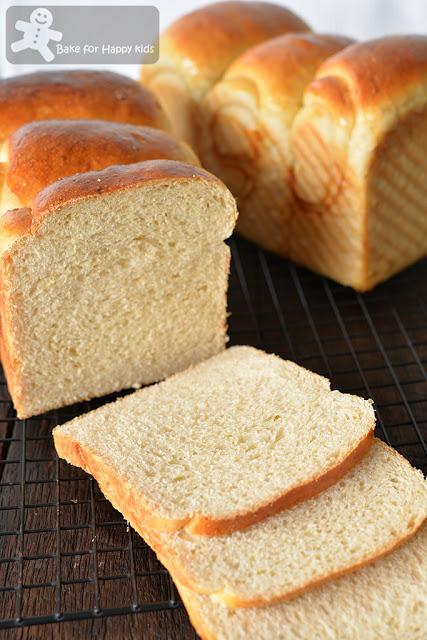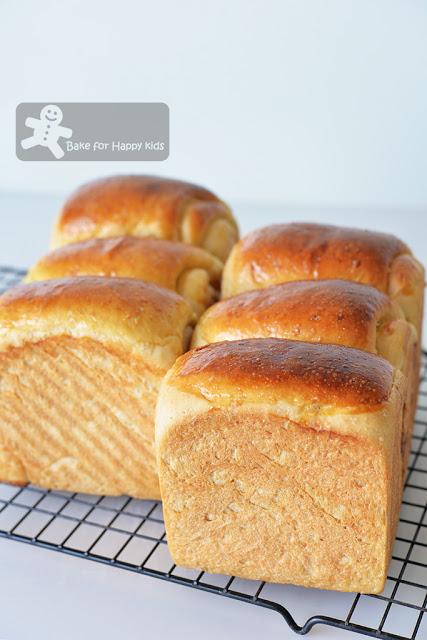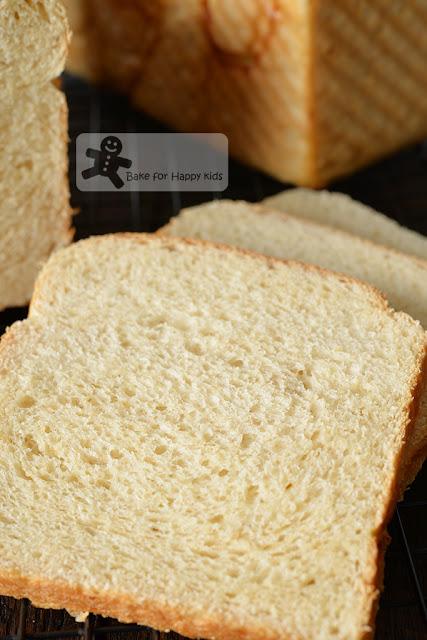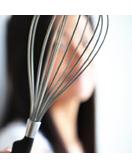Although these sandwich breads are not typically feathery, fluffy, cottony soft like these all-white breads that I have baked at here, here, here, here, here, here, here, here and here, they are pretty unique and delicious being soft and moist enough with tasty oats, milky and brown sugar flavours.
Don't you think that these oatmeal sandwich breads look somehow like 30% wholemeal milk breads that I have baked at here? Oh! Wait a minute. Is rolled oat a wholegrain? Are wholegrain and wholemeal the same?
According to Food Standard Australia, wholegrain food is any food which uses every part of the grain including the outer layers, bran and germ. And, wholemeal is the wheat form of a whole grain. According to Wholegrain Council, rolled oats also known as old fashioned oats are created when oat groats are steamed and then rolled into flakes. Thus, due to the fact that a rolled oat contains just the oat bran and doesn't contain the germ or the endosperm, a rolled oat is not considered a wholegrain!
So clearly, anything that is made with rolled oats is neither wholegrain nor wholemeal! Are you surprised with these answers? I am.
Regardless of all food definitions, I wouldn't say no to rolled oats and these oatmeal sandwich breads because the truth is oats are nutrient-rich food that are associated with lower blood cholesterol! So why would I say no to these healthful delicious soft oatmeal sandwich breads?

Soft and Deliciously-Milky Oatmeal Milk Sandwich Bread
Like most of the sandwich breads that I have baked, kneading these oatmeal bread dough using bread machine is easy. Even easier because oats can absorb and retain moisture making this non-sticky bread dough very extremely easy to handle.
Interestingly, the moisture-retaining oats can also help to make these sandwich bread to stay moist and soft! Well, seeing is believing! Watch my video and you will see what I meant...
However, with the addition of moisture-retaining oats and less gluten, these breads won't rise typically tall like all-white breads and won't be feathery light or cottony soft. Furthermore, the bread dough won't be typically elastic like most all-white dough. Instead, these oatmeal breads will rise well enough to stay soft and moist but need to be properly stored in airtight container to avoid any moisture loss from their less-fluffy texture.

To me, it is a must to apply egg yolk wash before baking
... so that the breads will have these nice soft delicious top crusts.

I'm impressed!!!
Love its soft moist texture and delicious oats, milky and brown sugar flavours!
I hope that you will love this healthful sandwich bread recipe as much as we do.
Like my healthy bread recipes? I promise that I will share more... To get the latest updates, you can follow me at either my Facebook at here or here or my Instagram @zoebakeforhappykids
Here's the recipe that I have adapted from Cookpad.
Make two 10 cm x 20 cm loaves
460g pasteurised fresh milk, not UHT, not scalded, NEED to be lukewarm at about 37°C (100°F)550g bread flour with 12% protein
50g milk powder
120g rolled / old fashioned oats
60g light brown sugar
6g salt
50g unsalted butter, softened at room temperature
2 1/2 tsp dry yeast
vegetable oil spray to grease the loaf pans
extra bread flour for dusting and shaping if required but I don't think you will need any because the dough will be so easy to handle.egg wash (1 egg yolk plus 1 tbsp milk) to brush the dough before baking
If you are using a breadmaker to knead and prove, add all ingredients into the breadmaker according to this order. Use "dough" setting to mix and knead dough for 30 mins or until the dough is smooth* with small bits of oats and allow the dough to prove for 1 hr.
If you are using an electric mixer with an hook attachment to knead, combine all ingredients except butter in the mixing bowl and mix at low speed until a soft dough forms. Then, knead in the butter until incorporated. Continue to knead at low speed for at least 25 mins or until the dough is smooth* with small bits of oats. Cover the dough and allow the dough to prove in a warm and humid place for about 1 hr or until doubled in size.
*Dough will be smooth but won't be as stretchy and elastic like the all-white dough due to the addition of oats.
To shape the dough into bread loaf:
Grease 10 x 20 cm loaf pans with vegetable oil spray. Divide dough into into 6 equal portions. Shape each portion of dough into smooth balls. Allow them to rest at room temperature for about 10 mins.Using a lightly floured rolling pin, roll each portion into long and flat oval shape (about 20 cm) on a lightly floured non-stick surface. Use your fingers to pick one shorter side of the dough and tuck and roll the dough like a Swiss roll. Use a rolling pin to flatten and roll the dough into a long rod shape. Then, pick one shorter side of the dough and roll it like a Swiss roll again. Repeat this rolling step with the remaining portions of dough.
Place three rolled dough with their seams side down into the each prepared pan. Press the top of the dough lightly to form an even surface. Allow the dough to prove in a warm and humid place for another 1 hr or until the dough is going to reach the maximum height of the loaf pan.
Brush the top of the dough with egg wash and bake breads in a preheated 180°C (350°F) oven for 20-22 mins or until the bread are thoroughly baked - These breads require slightly less baking time to bake. Cover breads very loosely with foil at the last 10 mins of baking if the top of the breads turn golden brown too quickly.
Remove breads from the loaf pans and transfer immediately onto a wire rack to cool completely before slicing.
To store, keep in airtight container at room temperature for 2-3 days or wrap and freeze in serving portions for 2-3 months. To ensure that the breads stay in their best form, I usually freeze them in serving portions on their day of bake.
Happy BakingPlease support me and like me at Facebook...

